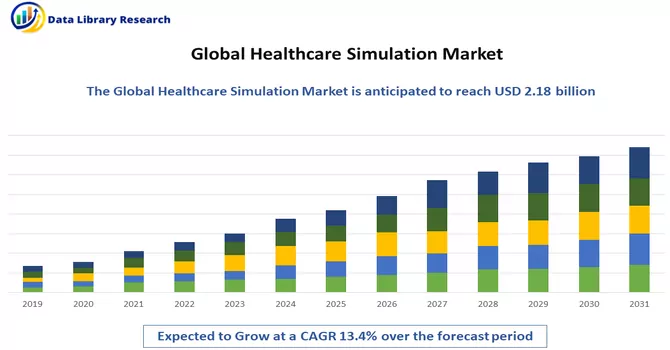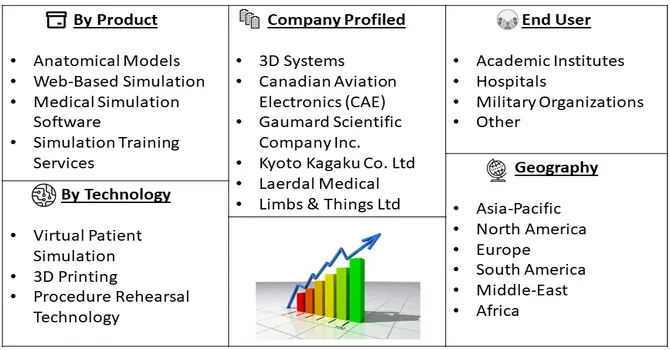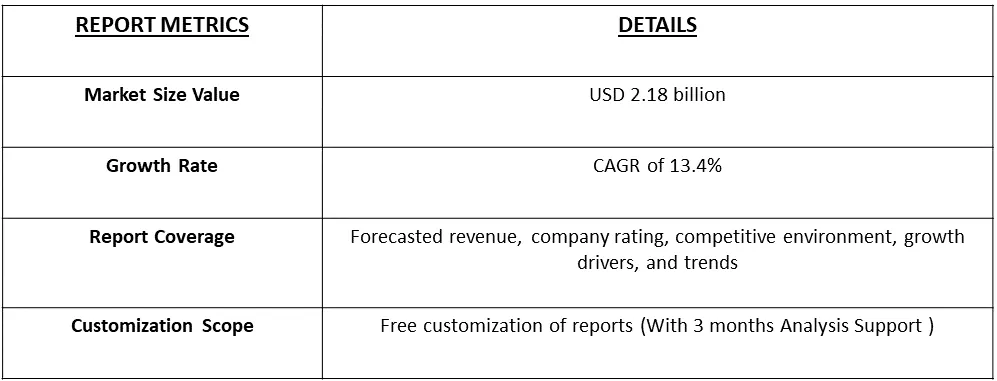The healthcare market is projected to register a CAGR of 13.4% during the forecast period, 2024-2031.

Get Complete Analysis Of The Report - Download Free Sample PDF
Healthcare simulation is a multifaceted approach that leverages various techniques and technologies to recreate real-world medical scenarios within a safe and controlled environment. One key aspect involves the use of lifelike mannequins capable of mimicking physiological responses and symptoms, enabling healthcare professionals to practice a range of procedures, patient assessments, and emergency interventions. Additionally, virtual reality (VR) and augmented reality (AR) play a crucial role by creating computer-generated environments or overlays that simulate medical scenarios, surgeries, and patient interactions, offering an immersive and interactive training experience. Standardized patients, portrayed by trained actors with specific medical conditions, provide another dimension to simulation, allowing healthcare professionals to hone their communication, history-taking, and physical examination skills in realistic settings. Task trainers, designed for specific skills or procedures, and computer-based simulations further contribute to the comprehensive landscape of healthcare simulation. Widely utilized in medical education and ongoing professional development, healthcare simulation not only facilitates skill-building but also enhances teamwork, communication, and the ability to navigate complex and critical situations. Moreover, it serves as a valuable tool for performance evaluation, identifying areas for improvement, and refining medical protocols in a risk-free learning environment.
The increasing emphasis on patient safety is another significant driver. Healthcare institutions and professionals are increasingly recognizing the value of simulation in creating a risk-free environment for practising and refining medical procedures. The ability to simulate complex scenarios allows healthcare providers to enhance their skills and decision-making processes, ultimately improving patient safety in real-world clinical settings. Moreover, the growing demand for minimally invasive treatments fuels the adoption of medical simulation. As medical procedures become more intricate and specialized, there is a rising need for healthcare professionals to master these techniques before applying them in actual patient care. Simulation provides a platform for practitioners to practice and perfect minimally invasive procedures, fostering confidence and competence in delivering advanced medical interventions.
Market Segmentation: The Healthcare Simulation Market is Segmented by Products and Services (Products, Services and Software), Technology (High-fidelity Simulators, Medium-fidelity Simulators, and Low-fidelity Simulatorsand Geography (North America, Europe, Asia-Pacific, Middle East and Africa, and South America). The market size and forecasts are provided in terms of value (in USD million) for the above segments.

For Detailed Market Segmentation - Download Free Sample PDF
The expansion of the medical simulation market is driven by several compelling factors, including ongoing advancements in technology, a heightened focus on patient safety, and a rising demand for minimally invasive treatment options. Technological progressions play a pivotal role, as continuous innovations in simulation technologies enhance the overall efficacy and realism of medical training. This, in turn, contributes to the market's growth by providing healthcare professionals with more sophisticated and realistic learning experiences. Thus, the dynamic growth of the medical simulation market is propelled by the continuous evolution of technology, an increased commitment to patient safety through simulated training environments, and the surging demand for effective preparation in the realm of minimally invasive treatments. These factors collectively underscore the crucial role of medical simulation in addressing the evolving needs of the healthcare industry.
Market Drivers:
Increasing Concerns over Patient Safety
The escalating concerns surrounding patient safety in the healthcare sector have precipitated a transformative shift towards the integration of healthcare simulation. Recognized as a pivotal element in medical education and training, simulation techniques, including mannequin-based simulations, virtual reality, standardized patients, and computer-based simulations, offer healthcare professionals a controlled and risk-free environment to hone their clinical skills and decision-making abilities. By immersing practitioners in realistic scenarios that mirror patient care situations and emergency responses, simulation addresses patient safety concerns on multiple fronts. This approach facilitates the practice of rare or high-risk procedures, fosters effective communication and teamwork skills, and identifies potential errors before they occur in real clinical settings. Furthermore, healthcare simulation aligns with the broader goal of continuous improvement in healthcare quality, contributing to a safer and more proficient healthcare workforce that can navigate the complexities of patient care with enhanced competence, ultimately fostering improved patient outcomes.
Increasing Demand for Minimally Invasive Treatments
The surging demand for minimally invasive treatments has underscored the pivotal role of healthcare simulation in meeting the evolving needs of healthcare professionals. As medical procedures become increasingly intricate and specialized, there is a growing preference for minimally invasive techniques that offer benefits such as reduced recovery times and minimized trauma to patients. In response to this demand, healthcare simulation has emerged as a valuable tool for training practitioners in the nuances of minimally invasive procedures. Simulation platforms enable healthcare professionals to practice and refine their skills in a realistic and controlled environment before applying them in actual patient care scenarios. This approach not only enhances proficiency in performing minimally invasive treatments but also contributes to improving patient safety and outcomes. The integration of simulation into medical education and training aligns with the healthcare industry's commitment to staying at the forefront of technological advancements, ensuring that practitioners are well-equipped to provide high-quality and innovative care. Ultimately, the synergy between the increasing demand for minimally invasive treatments and the adoption of healthcare simulation reflects a strategic response to the evolving landscape of modern healthcare, where precision and proficiency are paramount.
Market Restraints:
High Cost of Simulators
The high cost associated with healthcare simulators stands as a potential impediment to the rapid growth of the healthcare simulator market. While these simulation technologies play a pivotal role in medical education, training, and skill enhancement for healthcare professionals, their substantial upfront costs can pose a challenge for widespread adoption. The intricate design, advanced technology, and realistic features integrated into simulators contribute to their elevated price tags. Institutions, particularly those with budget constraints, may find it challenging to invest in these sophisticated simulation solutions. Additionally, ongoing maintenance, updates, and the need for specialized personnel to operate and manage these simulators contribute to the overall cost of ownership. As a result, the accessibility of healthcare simulators to a broader range of institutions and professionals may be limited, potentially slowing down the market's growth. Strategies such as cost-effective solutions, partnerships, and collaborative efforts within the healthcare industry may be crucial in mitigating these cost barriers and fostering wider adoption of simulation technologies.
Medical simulation has emerged as a pivotal component in the healthcare response to the COVID-19 pandemic across various medical institutions. Throughout the ongoing crisis, simulation training has been actively implemented in healthcare settings to refine protocols, instigate practice changes, uncover potential safety gaps, and provide training for redeployed healthcare professionals undertaking unfamiliar roles. A study titled "Implementation of Simulation Training During the COVID-19 Pandemic," published in Simulation in Healthcare in February 2021, underscores the significance of simulation in the pandemic response. It was recognized that simulation serves as a valuable tool in addressing system-based challenges, such as identifying safety gaps, formulating infection control strategies, and enhancing clinical management protocols. The study suggests that the versatility of simulation in disaster preparedness and crisis resource management made it particularly effective in dealing with the complexities brought about by the pandemic. Consequently, the healthcare industry has increasingly embraced medical simulation as an essential strategy during the pandemic, highlighting a positive impact on market growth.
Segmental Analysis:
Software Segment is Expected to Witness Significant Growth Over the Forecast Period
Healthcare simulation software plays a pivotal role in transforming medical education, training, and clinical practice by providing a virtual environment for healthcare professionals to enhance their skills and decision-making abilities. This software encompasses a wide range of applications, including virtual patient simulations, procedural training, and interactive medical scenarios. One key advantage of healthcare simulation software is its ability to replicate realistic clinical situations, allowing practitioners to practice and refine their responses in a risk-free and controlled setting. These software solutions often include advanced features such as realistic anatomical models, interactive 3D visuals, and dynamic physiological responses, contributing to a lifelike simulation experience. Virtual patient simulations enable healthcare professionals to engage with diverse patient cases, ranging from routine check-ups to complex medical emergencies. This not only facilitates the development of clinical expertise but also enhances communication and teamwork skills. Procedural training is another significant aspect of healthcare simulation software, providing a platform for practicing specific medical procedures, surgeries, or interventions. Whether it's surgical simulators for practicing intricate procedures or virtual reality applications for hands-on training, these software solutions offer a safe and immersive learning environment. Moreover, healthcare simulation software allows for scenario-based training, where practitioners navigate through simulated clinical situations, make decisions, and observe the consequences in a controlled virtual space. This aids in developing critical thinking skills and fostering a proactive approach to various healthcare challenges. As technology continues to advance, healthcare simulation software evolves with the integration of artificial intelligence, machine learning, and data analytics, further enhancing its capabilities. These advancements contribute to personalized learning experiences, adaptive simulations, and real-time feedback for continuous improvement. While healthcare simulation software offers numerous benefits, including increased accessibility and flexibility in training, challenges may arise in terms of cost, technology integration, and the need for ongoing updates. Nevertheless, the continuous development and adoption of sophisticated healthcare simulation software demonstrate its integral role in shaping the future of medical education and training, ultimately improving patient care outcomes.
High-fidelity Simulators Segment is Expected to Witness Significant Growth Over the Forecast Period
High-fidelity simulators stand at the forefront of healthcare simulation technology, offering an advanced and immersive training experience for healthcare professionals. These cutting-edge simulators closely replicate real-life clinical scenarios by incorporating realistic anatomical models, dynamic physiological responses, and advanced sensor technologies. They provide practitioners with a realistic environment to practice and refine their skills, make critical decisions, and master complex medical procedures. Particularly valuable in critical care, emergency medicine, and surgical specialities, high-fidelity simulators bridge the gap between theoretical knowledge and hands-on experience, allowing healthcare professionals to enhance their competence and confidence. Beyond individual skill development, these simulators also facilitate interprofessional education by promoting collaboration and teamwork among healthcare team members. While challenges such as initial costs and ongoing maintenance exist, the benefits in terms of improved patient safety, increased practitioner competency, and enhanced teamwork underscore the pivotal role of high-fidelity simulators in shaping the future of medical education and training.
North America Region is Expected to Witness Significant Growth Over the Forecast Period
North America is poised to assert its dominance in the medical simulator market throughout the forecast period, with several key factors contributing to its anticipated growth. The region's leading position is attributed to a combination of factors, including the increasing prevalence of chronic diseases necessitating surgical interventions, continuous technological advancements, and the presence of major industry players. A notable driving force is the rising incidence of chronic conditions, such as ischemic heart disease and chronic obstructive pulmonary disease, as reported by the Public Health Agency of Canada in December 2021. The statistics underscore the pressing need for advanced medical training solutions to address the complexities associated with these diseases. Moreover, the anticipated surge in cancer cases, as indicated by the Globocan 2020 report, further underscores the region's healthcare challenges. As the prevalence of chronic diseases continues to rise in North America, there is a corresponding expectation of increased adoption of medical simulators to enhance healthcare professionals' skills and preparedness.
The growing trend toward minimally invasive surgeries in the region is another significant factor contributing to the expansion of the medical simulation market. The adoption of simulation tools is particularly beneficial in facilitating hands-on training for real surgical procedures, aligning with the increasing preference for minimally invasive techniques. A study published in November 2021, titled 'Trends in the Use of Minimally Invasive Adnexal Surgery in the United States,' highlights the prevalence of minimally invasive surgery in various gynecological procedures, reflecting the broader industry shift. Furthermore, major players in North America have played a pivotal role in market growth by introducing innovative products. For example, in October 2020, GIGXR, Inc., a leading provider of immersive learning systems for medical simulation, launched the HoloPatient Remote and GIG Mobile, catering specifically to medical and nursing schools. These advancements in technology and product offerings contribute to the region's significant share in the medical simulation market. Thus, the North American region is poised to be a major player in the medical simulation market over the forecast period, driven by the escalating burden of chronic diseases, the increasing adoption of minimally invasive surgeries, and the continuous innovation brought forth by key industry players.

Get Complete Analysis Of The Report - Download Free Sample PDF
The medical simulation market exhibits a high degree of fragmentation, characterized by the presence of numerous players, predominantly comprising small and medium-sized enterprises. This diversity in market participants contributes to intense competition within the industry. In recent years, the market has witnessed a notable influx of new entrants, a trend attributed to the growing recognition and popularity of simulation technology in healthcare. This influx of new players has added dynamism to the competitive landscape. Within this competitive environment, existing players are strategically differentiating themselves by emphasizing key factors such as price, quality, and technological advancements. Price competitiveness serves as a focal point, with companies striving to offer cost-effective solutions to gain a competitive edge. Quality considerations also play a significant role, as consumers increasingly prioritize the reliability and effectiveness of medical simulation products and services. Some of the market players are:
Recent Development:
1) In March 2022, MedLern, a prominent provider of digital learning solutions for healthcare professionals and hospitals, introduced an innovative online resuscitation training platform that operates without the need for instructor oversight. This cutting-edge program, known as HeartCode Complete, has garnered global recognition and is co-developed in collaboration with the American Heart Association (AHA) and powered by Laerdal Medical technology. The platform offers a comprehensive and proven online resuscitation training experience, providing healthcare professionals with a flexible and effective way to enhance their skills in a self-directed manner.
2) In January 2022, Inovus Medical introduced a state-of-the-art high-fidelity hysteroscopy simulator named HystAR. This simulator stands out by incorporating Inovus Medical's patented augmented reality technology and a cloud-based learning platform, seamlessly integrating with the natural haptics of simulated tissue models. The result is an immersive and realistic hysteroscopy skills training experience that is not only highly authentic but also scalable. This innovative approach allows healthcare practitioners to refine their hysteroscopy skills in a tracked and effective manner, contributing to improved procedural proficiency.
Q1. What is the Growth Rate of the Healthcare Simulation Market ?
The Healthcare Simulation market is projected to register a CAGR of 13.4% during the forecast period.
Q2. What are the factors driving the Healthcare Simulation market?
Key factors that are driving the growth include the Increasing Concerns over Patient Safety and Increasing Demand for Minimally Invasive Treatments.
Q3. What segments are covered in the Healthcare Simulation market Report?
By Products and Services, By Technology, End-User and Geography these segments are covered in the Healthcare Simulation market Report.
Q4. Which Region is expected to hold the highest Market share?
North America region is expected to hold the highest Market share.
Data Library Research are conducted by industry experts who offer insight on industry structure, market segmentations technology assessment and competitive landscape (CL), and penetration, as well as on emerging trends. Their analysis is based on primary interviews (~ 80%) and secondary research (~ 20%) as well as years of professional expertise in their respective industries. Adding to this, by analysing historical trends and current market positions, our analysts predict where the market will be headed for the next five years. Furthermore, the varying trends of segment & categories geographically presented are also studied and the estimated based on the primary & secondary research.
In this particular report from the supply side Data Library Research has conducted primary surveys (interviews) with the key level executives (VP, CEO’s, Marketing Director, Business Development Manager and SOFT) of the companies that active & prominent as well as the midsized organization
FIGURE 1: DLR RESEARH PROCESS

Extensive primary research was conducted to gain a deeper insight of the market and industry performance. The analysis is based on both primary and secondary research as well as years of professional expertise in the respective industries.
In addition to analysing current and historical trends, our analysts predict where the market is headed over the next five years.
It varies by segment for these categories geographically presented in the list of market tables. Speaking about this particular report we have conducted primary surveys (interviews) with the key level executives (VP, CEO’s, Marketing Director, Business Development Manager and many more) of the major players active in the market.
Secondary ResearchSecondary research was mainly used to collect and identify information useful for the extensive, technical, market-oriented, and Friend’s study of the Global Extra Neutral Alcohol. It was also used to obtain key information about major players, market classification and segmentation according to the industry trends, geographical markets, and developments related to the market and technology perspectives. For this study, analysts have gathered information from various credible sources, such as annual reports, sec filings, journals, white papers, SOFT presentations, and company web sites.
Market Size EstimationBoth, top-down and bottom-up approaches were used to estimate and validate the size of the Global market and to estimate the size of various other dependent submarkets in the overall Extra Neutral Alcohol. The key players in the market were identified through secondary research and their market contributions in the respective geographies were determined through primary and secondary research.
Forecast Model
